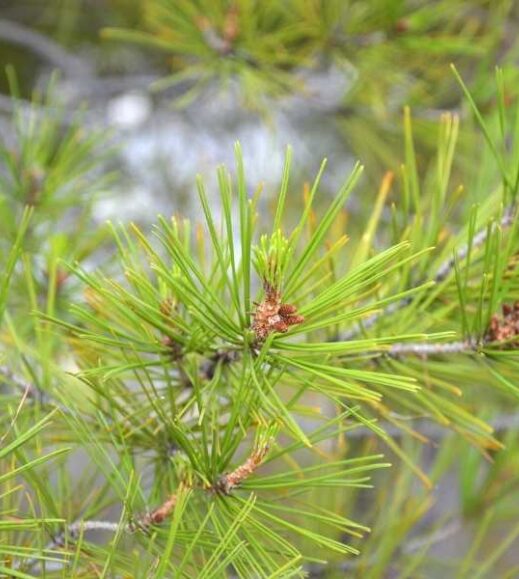Propagate | Soil | Light | Water | Temperature | Humidity | Potting | Pruning | Fertilize | Pest Control | FAQs
The Aleppo pine, also known as the Jerusalem Pine, is a coniferous tree native to the Mediterranean region. It is a long-living evergreen that can reach heights of up to 25 meters. This hearty species is highly drought tolerant and prefers full sun with well-draining soils. Its needles are short and greyish-green, while the bark is scaly and red-brown.
Aleppo pine plants are relatively low maintenance and easy to grow. They develop an attractive pyramid shape with age and can tolerate heavy pruning if desired. In addition, they are very hardy and resistant to most pests and diseases. However, improper care or lack of water can cause the tree to become stressed and suffer from dieback.
Pinus halepensis (Aleppo Pine) Tree Seed, borne Needles, Long, Oval to Oblong, Reddish to Yellow Brown Cones
This guide will give you all the information necessary to provide your Aleppo pine plant with proper care, including watering, pruning, fertilizing, and pest control. With the right knowledge and techniques, you can be sure that your Aleppo pine will thrive in your garden for years.
Do Aleppo pine flower? What color is the Aleppo pine flower?
Aleppo pine plants are monoecious, meaning they have male and female cones. The female cones are yellow-green, while the male cones are pinkish-brown. The female cones produce small yellow flowers that appear in early spring and can produce a pleasant, earthy scent. The male cones produce pollen, which wind-borne pollinators transfer to the female cones. It is important to note that Aleppo pine trees can be very slow to flower and may only bloom once they are ten years old or more. When flowers appear, they are usually located near the tips of branches in clusters.
Since Aleppo pines are generally slow to flower, they should not be expected to produce fruit in the garden.
When to plant the Aleppo pine plant?
Generally, it is advisable to plant Aleppo pine in the late autumn or early winter when temperatures are consistently cooler. Since Aleppo pines prefer full sun, they should be planted in an area of the garden that receives at least six to eight hours of direct sunlight per day. When planting Aleppo pines, it is important to ensure that the tree is in an area with well-draining, sandy soil.
Aleppo pine soil requirements: What is the best soil for the Aleppo pine plants?
Aleppo pine plants prefer sandy, well-draining soils that are neutral to slightly alkaline in pH. The soil should be kept consistently moist but not too soggy. If the soil is too heavy or clayey in texture, it should be amended with organic matter to improve drainage.
It is also important to ensure that the soil is not waterlogged, as this can lead to root rot and other issues. To help prevent this, make sure to plant your Aleppo pine in an area with good airflow and plenty of space between other plants.
Adding amendments and enhancers can also help to improve the soil quality and help your Aleppo pine thrive. Adding organic matter, such as composted manure or aged wood chips, can help improve drainage and nutrient levels in the soil. Additionally, adding fertilizers such as compost tea or slow-release fertilizer can help to provide your Aleppo pine with essential nutrients.
Aleppo pine light requirements: How much light does Aleppo pine plant need?
Aleppo pine plants need full sun to thrive. This means they should be planted in an area of the garden that receives at least six to eight hours of direct sunlight per day. If this is impossible, plant grow light can help provide your Aleppo pine with the light it needs to photosynthesize and grow. It is important to note that Aleppo pines need a lot of light, so be sure to move the grow light around frequently to distribute it evenly.
Aleppo pine water requirements: How often to water the Aleppo pine plant?
Generally, it is best to water your Aleppo pine deeply and infrequently. This means you should wait until the soil is completely dry before watering again. Be sure to check the soil frequently and adjust the frequency of watering accordingly. It is important to note that too much water can lead to root rot and other issues, so be sure to water only when needed.
An irrigation system can help ensure your Aleppo pine gets the water it needs without overwatering. Drip irrigation systems are particularly effective as they can be adjusted to provide the exact amount of water your Aleppo pine needs.
Aleppo pine temperature range: What temperature can Aleppo pine tolerate?
Aleppo pine plants can tolerate temperatures ranging from 0°C to 45°C. It is important to note that the lower the temperature, the slower the growth rate of your Aleppo pine. Temperatures above 45°C can damage the foliage and drain the plant of its moisture, so be sure to provide some shade and additional water during extreme heat.
To protect plants during bad weather, you can benefit from using a greenhouse, cold frame, and plant protective cover to protect your Aleppo pine from extreme conditions.
Aleppo pine humidity: Do Aleppo pine like humidity?
Aleppo pine plants prefer a humid environment and thrive in areas with high humidity levels. If your area tends to be very dry, use a humidifier near your Aleppo pine plants to maintain the proper moisture level. Also, periodically misting your Aleppo pine plants' foliage can help increase humidity and reduce water loss.
To maintain the humidity of plants around your Aleppo pine, you should plant other plants with similar moisture requirements. This will help to keep the humidity in the surrounding area consistent and provide your Aleppo pine with the right environment.
Aleppo pine plant propagation: How to propagate Aleppo pine plant?
Several methods of propagating plants include cuttings, division, layering, and grafting. However, the most common method of propagating Aleppo pine is by cutting.
Propagating Aleppo pine plant by cutting
Aleppo pine plants can be propagated using stem cuttings, usually 4-6 inches long. The bottom of the cut should be made with a sharp knife, and the top should remain uncut. The cuttings can then be planted in a well-drained, light soil mix and kept slightly moist. Once the cuttings have taken root, you can transplant them into individual pots or your garden.
Propagating Aleppo pine plant by division
Aleppo pines can also be propagated by dividing the roots. This is a great way to quickly and easily create multiple plants. To divide the roots, gently dig around the base of your Aleppo pine plant and carefully pull the clump apart. Then, replant the divisions in a well-draining soil mix and keep them slightly moist until the roots re-establish.
Propagating Aleppo pine plant by layering
Layering is another method of propagating Aleppo pine plants. This method involves bending a branch of your Aleppo pine plant down to the ground and then covering a portion of the stem with soil. Once the branch has taken root, you can cut it from the mother plant and transplant it into its pot or your garden.
Grafting is yet another propagation method for Aleppo pine plants. This requires a bit more skill and experience, but if done correctly, it can be a great way to produce multiple plants that share the same characteristics as the mother plant.
Potting Aleppo pine plant
Aleppo pine plants do best in a well-drained, light soil mix. If you plan on keeping your Aleppo pines in containers, use a potting mix specifically formulated for container plants.
You should also ensure that your containers have adequate drainage holes in the bottom. This will help to ensure that the roots of your Aleppo pine plants are not sitting in stagnant water.
It's important to select the correct pot size or container for your Aleppo pine plants. If you choose a pot that is too small, the roots may become rootbound and struggle to absorb nutrients. On the other hand, if you choose a pot that is too large, the soil may become overly soggy, and your Aleppo pine plants may be more prone to fungal diseases.
How to prune Aleppo pine plant?
Pruning is important for the overall health of your Aleppo pine plants. Pruning helps to remove dead or diseased branches, encourages new growth, and can even help shape an Aleppo pine plant into the desired form.
When pruning an Aleppo pine, it is important to use clean and sharp tools. This will help to reduce the risk of spreading a disease or damaging the plant. When pruning, remove any dead or diseased branches and then shape the plant.
When pruning an Aleppo pine, you should always aim for a symmetrical look. This will help to keep your Aleppo pine looking its best. It is important to note that Aleppo pines should be pruned in the early spring before new growth begins. This will help to ensure that the plant is not damaged and can start the growing season off on a healthy note.
How to fertilize Aleppo pine plant?
Fertilizing an Aleppo pine plant is important for its overall health and growth. Fertilize your Aleppo pine plants in the early spring before new growth begins and then again in midsummer.
When fertilizing an Aleppo pine, it is important to use a balanced fertilizer specifically formulated for conifers. You should also avoid using a fertilizer with high nitrogen content, as this can cause the foliage to become too dense and weaken the branches.
When applying fertilizer, you should evenly spread it around the base of the plant and water it well. It is important to note that you should never fertilize dry soil, as this can burn the roots of your Aleppo pine plants.
Choose a high-quality fertilizer with a balanced NPK ratio to fertilize your Aleppo pine. Some of the plants also benefit by adding appropriate soil amendments.
Common Aleppo pine diseases and how to manage Aleppo pine disease?
Aleppo pine plant is prone to a few common pests and diseases, including:
Root rot: Root rot is caused by overwatering and poor drainage and will cause the roots of your Aleppo pine to turn brown or black. To prevent root rot, ensure to water your Aleppo pine plants only when necessary and avoid overwatering.
Fungal disease: Fungal diseases such as powdery mildew and needle blight can cause yellowing of the foliage or black spots on the needles. To prevent these diseases, keep your Aleppo pine plants in an area with good air circulation and prune any dead or diseased branches.
Spider mites: Spider mites can cause discoloration and tiny web-like structures on the needles of your Aleppo pine plants. To prevent these pests, keep your plants in an area with good air circulation and clean the foliage. You can also use insecticidal soap or horticultural oils to control spider mites.
Caterpillars: Caterpillars can cause holes in the needles of your Aleppo pine plants. To prevent caterpillars, keep your plants in an area with good air circulation and prune any dead or diseased branches. You can also use insecticidal soap or horticultural oils to control caterpillars.
In case of an outbreak, Use good-quality insecticides and fungicides. Always follow the instructions correctly. The most important part is prevention; once you spot any problems, treat them as soon as possible to get them under control.
Takeaway on how to grow and care for Aleppo pine
Growing and caring for Aleppo pine plants isn't difficult, but keeping a few basic things in mind is important. Make sure to plant your Aleppo pine plants in an area with good air circulation and prune any dead or diseased branches. Use insecticidal soap or horticultural oils to prevent pests like spider mites and caterpillars. In case of outbreaks, use good quality insecticides and fungicides and always follow the instructions correctly. Lastly, remember that prevention is key - if you spot any problems early on, take action immediately to get them under control. With the right care, your Aleppo pines should be healthy and beautiful for years to come!
Explore our plant grow and care guides collection to add more plants to your garden.
Join our supportive AgFunnel community of gardeners. Share a picture of your garden and receive support from fellow plant lovers. Happy gardening.
FAQs
What is Aleppo pine?
Aleppo pine is an evergreen tree native to North Africa and the Mediterranean region. It can grow up to 40 feet tall and is characterized by its dense, dark foliage and long, thin needles. The wood of the Aleppo pine is highly prized for its strength and durability.
Where to put Aleppo pine?
Aleppo pine can be planted in most climates as long as the location receives full sun and has good air circulation. It is best to avoid areas with high winds, as this could damage the delicate foliage. Choosing an area with well-draining soil is also important, as wet and soggy soil can lead to root rot.
How often should Aleppo pine be watered?
Aleppo pine should be watered regularly, but only a few times. The soil should be allowed to dry out slightly between waterings. During the summer months, the plant should be watered every 1-2 weeks; in the winter, it should only be watered every 3-4 weeks. Over-watering can lead to root rot, so monitoring the soil moisture and adjusting accordingly is important.
How to get Aleppo pine to bloom?
Aleppo pine can take up to 10 years or more to bloom, so patience is key. To encourage blooming, ensure the plant gets enough sunlight and water. Prune any dead or diseased branches to increase air circulation and help reduce pest infestations. Fertilize with an all-purpose fertilizer at least once a year to provide the necessary nutrients for blooming. Lastly, ensure the soil is well-draining and free of pests or diseases.
Does Aleppo pine plant like sun or shade?
Aleppo pine does best in full sun but can tolerate a bit of shade. Too much shade will inhibit growth and blooming, so ensure that any shady spots are balanced with extra sunlight. In hot climates, partial shade is recommended to prevent leaf scorch and sunburn on the foliage.
Is the Aleppo pine plant annual or perennial?
Aleppo pine is a perennial evergreen, meaning it can live for many years. It does require regular pruning and maintenance to keep it looking its best, but with the right care, it can be a beautiful addition to any garden.
Does the Aleppo pine plant come back every year?
Aleppo pine is a perennial evergreen, meaning it will come back year after year with the right care. Prune any dead or diseased branches and provide ample sunlight, water, and nutrients throughout the year. If you follow these tips, your Aleppo pine should remain healthy and beautiful for years.
Are Aleppo pine plants toxic to cats?
No, Aleppo pine is not toxic to cats. However, they should not be ingested as the needles can cause an upset stomach. Additionally, the sap of the Aleppo pine can irritate skin and eyes, so it's important to keep your cat away from any areas where the sap may be present.
Are Aleppo pine plants toxic to dogs?
No, Aleppo pine is not toxic to dogs. However, they should not be ingested as the needles can cause an upset stomach. Additionally, the sap of the Aleppo pine can irritate skin and eyes, so it's important to keep your dog away from any areas where the sap may be present.
Are Aleppo pine plants toxic to pets?
No, Aleppo pine is not toxic to pets. However, they should not be ingested as the needles can cause an upset stomach. Additionally, the sap of the Aleppo pine can irritate skin and eyes, so it's important to keep your pet away from any areas where the sap may be present.
How cold can Aleppo pine plants tolerate?
Aleppo pine is quite a cold hardy and can tolerate temperatures down to -15 degrees Fahrenheit. However, it's important to note that the plant can suffer damage from extreme cold weather, so it's best to provide shelter or protection if necessary.
How often to water the Aleppo pine plant?
Aleppo pine should be watered regularly, but only a few times. The soil should be allowed to dry out slightly between waterings. During the summer months, the plant should be watered every 1-2 weeks; in the winter, it should only be watered every 3-4 weeks. Over-watering can lead to root rot or so.
When to stop watering the Aleppo pine plant?
Aleppo pine should be allowed to dry out slightly between waterings. During the summer months, when temperatures are warmer and rainfall is more frequent, the plant should be watered every 1-2 weeks. When temperatures are cooler and rainfall I,s less frequent, watering should only occur every 3-4 weeks in the winter. When the soil is dry to a depth of 2 inches, it's time to stop watering.
When to fertilize the Aleppo pine plant?
Fertilization should occur twice a year—once in the spring and once in the fall. In the spring, use a balanced fertilizer containing nitrogen and phosphorus. In the fall, use a fertilizer with higher potassium levels to help promote root growth. Cover the entire root zone with the fertilizer and water it after application.
Can I Use Similar Care Techniques for Growing Aleppo Pine and Christmas Cactus?
Yes, you can use similar care techniques for growing Christmas cactus plant and Aleppo pine. Both require well-draining soil, adequate sunlight, and regular watering. However, it's important to note that Aleppo pine is a cold-hardy evergreen, while Christmas cactus is a tropical succulent.
Where to buy Aleppo pine plant?
Aleppo pine is widely available at most nurseries and garden centers. It's also possible to find them online from nurseries or individual sellers. Read reviews and research before purchasing, as not all plants are good quality. When purchasing online, look for plants labeled "disease-free" and ensure they have been inspected by a reputable nursery or garden center.

How to master gardening? Download these essential home and gardening ebooks today!

















